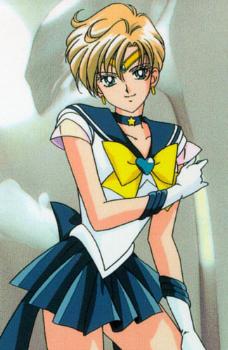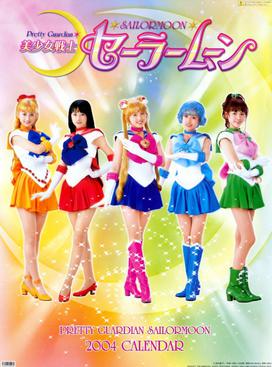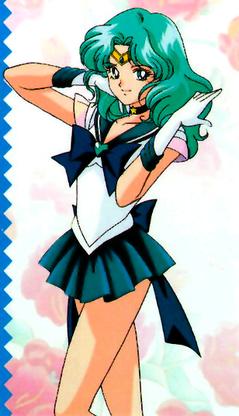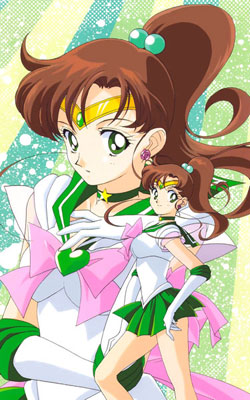Senshi may refer to:
- Senshi (wrestler), American professional wrestler Brandon Silvestry (born 1979)
- Sailor Senshi, a team of ten magical girls in the manga series Sailor Moon
- A fictional skilled gunfighter in the manga series Grenadier
Senshi may refer to:

Sailor Saturn is a fictional supporting character in the Sailor Moon manga, the 1992–1997 anime series created by Naoko Takeuchi and the 2014–2023 reboot that more closely follows the manga. Her spirit resides deep within twelve-year-old Hotaru Tomoe, a frail middle schoolgirl who is her lookalike reincarnation, which makes Sailor Saturn her alter ego; entirely apart from how the other nine Sailor Guardians are reborn and their human identities entirely separate.

Sailor Uranus is a fictional lead character in the Sailor Moon media franchise. Sailor Uranus' alternate identity is Haruka Tenou, a teenage Japanese student and race car driver. Haruka is a member of the Sailor Guardians, female supernatural fighters who protect the Solar System from evil.

Pretty Guardian Sailor Moon is a Japanese tokusatsu superhero television series based on the Sailor Moon manga created by Naoko Takeuchi. It was produced by Toei Company.

Sailor Neptune is a fictional lead character in the Sailor Moon media franchise. Her alternate identity is Michiru Kaiou, a teenage Japanese schoolgirl and violinist. Michiru is a member of the Sailor Soldiers, female supernatural fighters who protect the Solar System from evil.

The Sailor Moon musicals, commonly referred to as Sera Myu, are a series of live theatre productions based on the Sailor Moon manga by Naoko Takeuchi. The series consists of 31 musicals which have had more than 800 performances since the show opened in the summer of 1993. The first set of musicals, which ran from 1993 to 2005, were produced by Bandai with over 500 performances. The current musicals have been produced by Nelke Planning since 2013.
Kaori is a feminine Japanese given name. Notable people with the name include:

Sailor Moon Sailor Stars, or simply Sailor Stars, is the fifth and final season of Sailor Moon, a Japanese magical girl anime series based on the Sailor Moon manga series by Naoko Takeuchi; the season was directed by Takuya Igarashi and produced by Toei Animation. Like the rest of the Sailor Moon series, it follows the adventures of Usagi Tsukino and her fellow Sailor Guardians. The season is divided into two story arcs, with the first 6 episodes consisting of a self-contained arc exclusive to the anime in which the Sailor Guardians encounter Queen Nehelenia again. The remaining 28 episodes adapt material from the "Stars" arc of the manga, in which the Sailor Guardians meet up with the Sailor Starlights, led by Princess Kakyuu. They discover that Sailor Galaxia, the leader of the "Shadow Galactica" organization and a corrupted Sailor Guardian, plans to increase her powers and rule the Milky Way.
Kaguya, Kaguya-hime, or Princess Kaguya may refer to:

The third season of the Sailor Moon anime series, Sailor Moon S, was produced by Toei Animation and directed by Kunihiko Ikuhara. It began broadcasting on TV Asahi on March 19, 1994, and ended on February 25, 1995. It adapts the "Infinity" arc of the Sailor Moon manga series by Naoko Takeuchi, and follows the adventures of Usagi Tsukino and her fellow Sailor Guardians. In this season, they must fight against the Death Busters, who are planning to take over Earth. In 2000, Cloverway Inc. licensed the season for an English-language broadcast in North America. Optimum Productions dubbed the season, continuing over from the first two seasons that were licensed by DIC Entertainment and General Mills' The Program Exchange. The series aired on YTV in Canada, who adjusted the episode numbers to match those of the original Japanese version, from June 12, 2000, to August 1, 2000. The season later aired on Cartoon Network's Toonami programming block in the United States. Edited and unedited VHS tapes and uncut bilingual DVDs of their adaptation were released by Pioneer Entertainment. In contrast to DIC's handling of the first two seasons, Cloverway retained the background music and sound effects from the original Japanese version. Eventually, the season was re-licensed by Viz Media in 2014 for an updated English-language release, produced by Studiopolis. The first 18 episodes of the season were released as Part 1 on November 15, 2016, and the remaining 18 episodes were released as Part 2 on June 20, 2017. While Sailor Moon S began very similarly to the first two seasons, it eventually took a darker, more emotional turn.

Bishōjo Senshi Sailor Moon: Another Story is a role-playing video game developed and published by Angel exclusively for the Super Famicom in Japan on 22 September 1995. Based upon Naoko Takeuchi's Sailor Moon shōjo manga and anime series, the game takes place between the third season and fourth season of the anime series, which adapted the third and fourth arcs of the manga respectively, as players take control of either the five Inner Guardians or the four Outer Guardians in order to protect Crystal Tokyo by fighting against a group of rebels and several of their previously defeated enemies once again that were resurrected by the sorceress Apsu.

Chibiusa is one of the main characters from the Sailor Moon manga series created by Naoko Takeuchi. She is introduced in Chapter 14, "Conclusion and Commencement, Petite Étrangere", first published in Nakayoshi on July 6, 1993. She is a small child from the 30th century who time travels to the past to seek help from the Sailor Guardians. She later returns, a few years older, in order to train as a Sailor Guardian herself—Sailor Chibi Moon, translated as "Sailor Mini Moon" in the DIC and Cloverway English adaptations.

Makoto Kino, better known as Sailor Jupiter, is a fictional character in the Sailor Moon manga series created by Naoko Takeuchi. Makoto is her sailor form's alternative human identity as part of the Sailor Guardians, female supernatural fighters who protect the Solar System from evil.

Sailor Moon Crystal, known in Japan as Pretty Guardian Sailor Moon Crystal, is a Japanese anime series based on the shōjo manga series Sailor Moon written and illustrated by Naoko Takeuchi, produced in commemoration of the original series' 20th anniversary. Produced by Toei Animation and directed by Munehisa Sakai and Chiaki Kon, the series was streamed worldwide on Niconico from July 5, 2014, to July 18, 2015. Season 1 and 2's episodes were released twice a month. Instead of remaking the 1990s anime series preceding it, Toei Animation produced Crystal as a reboot of Sailor Moon and as a more faithful adaptation of the original manga by omitting much of the original material from the first series. The story focuses on Usagi Tsukino, who is a young girl that obtains the power to become the titular character. Other Sailor Guardians join her in the search for Princess Serenity and the Silver Crystal.

Pretty Soldier Sailor Moon S is a fighting game developed by Tose and published by Bandai exclusively for the 3DO Interactive Multiplayer in Japan on 17 March 1995. It is based upon Naoko Takeuchi's Sailor Moon shōjo manga and anime series, though its gameplay has been compared with other titles in the same genre such as SNK's Samurai Shodown. Loosely following the third season of the anime series, which adapted the third arc of the manga, the players control either one of the five original Inner Senshi or one of the three Outer Senshi as they enter a tournament to fight against each other and become the winning victor. Takeuchi supervised the production of the project and seiyūs from the anime series returned to reprise their roles.

Sailor Moon is a side-scrolling beat 'em up video game originally developed and released by Angel in Japan on August 27, 1993 and later in France and Spain in November 1994 by Bandai for the Super Nintendo Entertainment System. It is the second game to be created by Angel based upon Naoko Takeuchi's Sailor Moon shōjo manga and anime series, the first for the Super NES and one of the few Sailor Moon titles that had an official international release.

Bishōjo Senshi Sailor Moon R is a side-scrolling beat 'em up video game developed by Angel and published by Bandai in Japan on December 29, 1993. It is the third game to be created by Angel based upon Naoko Takeuchi's Sailor Moon shōjo manga and anime series, as well as the second title in the franchise for Super Famicom, serving as the sequel to Sailor Moon.

Bishōjo Senshi Sailor Moon SuperS: Shin Shuyaku Sōdatsusen is a 1996 fighting video game developed and published by Angel for the PlayStation and Sega Saturn. It is based upon Naoko Takeuchi's Sailor Moon shōjo manga and anime series. Loosely following the fourth season of the anime series, which adapted the fourth arc of the manga, the players control either one of the five original Inner Senshi or one of the four Outer Senshi as they enter a tournament to fight against each other and become the winning victor. The game was created by most of the same team who worked on previously released fighting titles in the Sailor Moon franchise for the Super Famicom at Angel.

Bishōjo Senshi Sailor Moon S: Jōgai Rantō!? Shuyaku Sōdatsusen is a 1994 fighting video game developed by Arc System Works and published by Angel for the Super Famicom. It is based upon Naoko Takeuchi's Sailor Moon manga and anime series and stars heroic teenage girls who represent the major celestial bodies of the solar system. The player takes control of one of the girls who have decided to stage a fighting tournament to determine who should lead the group.